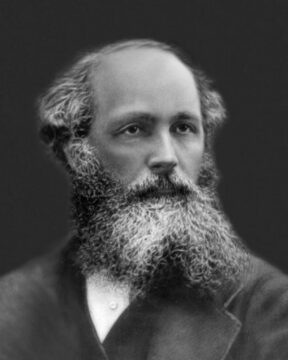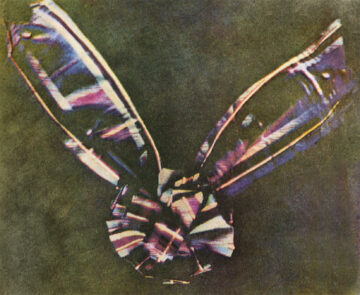by Monte Davis

Only a moment ago he asked Mrs. Murdoch to fetch his parents. Now all three are standing in the kitchen doorway, watching the reflected sunlight that skitters above the stove, across the ceiling. When he notices the adults, he mischievously directs it into their eyes. John Clark Maxwell squints and raises a hand to block the glare, but his voice is indulgent. “What are you up to, Jamesie?”
“It’s the sun, papa. I got it in with this tin plate.”
Before the afternoon is over, Jamesie will roll the plate around the pantry floor until Mrs. Murdoch sends him outside; beat it as a drum, marching against Napoleon with the Iron Duke; fill it with pink granite pebbles; empty it again, set it afloat on the duck pond, and bombard it with pebbles until it is swamped by the interlacing waves.
1
The antenna turns slowly against the spin of the earth, tracking a galaxy eight billion light-years away. That far away, that long ago, the galaxy’s core was exploding with unimaginable violence. Here and now, the radio outburst is almost lost in background noise. Penzias and Wilson thought that the noise in their antenna might be caused by pigeon droppings. Instead, it was the echo of the Big Bang.
Where did the Big Bang go? Into waves.
Waves in what?
In the field. The electromagnetic field. Maxwell’s field.
What is the field?
It’s like the water for ocean waves. It’s like the air for sound waves. It’s like the earth for seismic waves. It’s like…
No, it isn’t. We’ve just forgotten how strange it was.
Penzias and Wilson weren’t the first to have noise problems. Their radio astronomy traced back to Karl Jansky, trying to understand annoying static from nowhere on earth. Which went back to Marconi, who made a revolution out of a laboratory curiosity. Which went back to Heinrich Hertz in a darkened room at Karlsruhe, adjusting the gap between two brass spheres until he saw a spark: the first deliberate radio message. Which was only part of a message from James Clerk Maxwell that is still unfolding.
“One cannot escape the feeling,” Hertz would write of Maxwell’s equations, “that these formulae have an independent existence and an intelligence of their own, that they are wiser than we are, wiser even than their discoverers, that we get more out of them than was originally put into them.” That was poetic license, of course.
“A more thorough mathematical study of Maxwell’s equations,” Einstein went on, “shows that new and really unexpected conclusions can be drawn and the whole theory submitted to a test on a much higher level…”
Come now; you can’t really get more out of them than was originally put into them. According to information theory, you can’t get even that much.
“A great part of twentieth-century physics and mathematics could have been created in the nineteenth century,” Freeman Dyson wrote, “simply by exploring to the end the mathematical concepts to which Maxwell’s equations naturally lead.”
What are you up to, Jamesie?
2
At the moment, Professor Maxwell is staying too late at the Cavendish Laboratory again. He looks in on young Glazebrook, who is measuring light refraction in prisms of Iceland spar. It is the spring of 1879, five years since the building opened, but Professor Maxwell still supervises research as carefully as he planned and equipped the building.
The refraction measurements agree with theory to one part in ten thousand. It’s sound work, as solid as anything being done in Germany. So much for the doubters at Nature who seemed to think it shameful for Fellows of Trinity to be messing about with apparatus!
Pain wrenches at Maxwell’s gut. He retreats to his office for some carbonate of soda in a glass of water. He should go home to Katherine, but perhaps… yes, just a little more work on the latest proof sheets of the Cavendish book. How prescient the man was, anticipating so much of the work of Ohm, Ampere, even Faraday — and publishing scarcely any of it, the d—l take him!
In a few months, An Account of the Electrical Researches of the Honourable Henry Cavendish, F.R.S., between 1771 and 1781 will go to press. A month after that, Professor Maxwell will die of cancer of the stomach at 48.
3

“You know in part, at least, how in this case the promise of youth was more than fulfilled, and how the man who, but a fortnight ago, was the ornament of the University, and — shall I be wrong in saying it? — almost the discoverer of a new world of knowledge, was even more loved than he was admired, retaining after twenty years of fame that mirth, that simplicity, that childlike delight in all that is fresh and wonderful, which we rejoice to think of as the surest accompaniment of scientific genius…”
The eulogist will prove in stately periods that science, Christianity, and fame are compatible. But many in the chapel are thinking of Maxwell’s terrier, which would chase its tail until he gestured, then reverse direction, again and again, until he brought it to rest like the balance-wheel of a watch. Or of the “devil on two sticks,” the gyroscopic toy that was never out of his hands for long.
“Wheels within wheels,” we say of a complex machination. It was the baroque epicyclic complexity of Ptolemy’s astronomy that drove Kepler to demolish the starry spheres. Descartes offered swirling intangible vortices to replace them, but Newton needed only the reach of gravity to pull together a new cosmos of ellipses, parabolas, hyperbolas. He confessed misgivings:
“…that one body may act on another at a distance through a vacuum, without the mediation of anything else, by and through which their action and force may be conveyed from one to another, is to me so great an absurdity that I believe no man who has in philosophical matters a competent facility for thinking can ever fall into it.”
Yet it worked. Until Faraday started messing about with apparatus, and saw lines of force, as real to him as iron filings, around every charge, magnet, and current. Newton’s heirs were not amused. “I declare,” sniffed the Astronomer Royal, “I can hardly imagine anyone, who knows the agreement between observation and calculation based on action at a distance, to hesitate an instant between this simple and precise action, on the one hand, and anything so vague and varying as lines of force on the other.”
Worse was to come. In 1855, 24-year-old Maxwell began to extend Faraday’s ideas in a ten-year campaign rich with mechanistic models that he discarded as a deeper, simpler structure emerged. “I was at first almost frightened when I saw such mathematical force made to bear upon the subject,” Faraday admitted, “and then wondered to see that the subject stood it so well.” In 1861, Maxwell’s article “On Physical Lines of Force” offered the earliest form of equations that could be used to describe and predict all the known phenomena of electrical charges, magnets, and their motions. In 1865’s “A Dynamical Theory of the Electromagnetic Field,” he showed that all waves in the field propagated at one definite velocity: the speed of light (and of all the “light” we cannot see, from radio to gamma rays.)
But waves in what? Maxwell would write in the Encyclopedia Britannica: “there can be no doubt that the interplanetary and interstellar spaces are not empty, but are occupied by a material substance…” That would be the ether, dimly remembered as one of our poor benighted ancestors’ missteps like phlogiston. In 1887 Michelson and Morley sought experimental evidence for it — mounted lights and mirrors, slits and lenses on a stone slab, set the slab afloat in mercury, and took their readings on tiptoe, after midnight (no fluid waves, no sound waves, no seismic waves, please). And… no ether. Waves in nothing. Too bad about Maxwell. Even the greatest need to be set straight sometimes, right? But quite early on, Maxwell’s peers understood that he had wrought better than he knew.
FitzGerald, 1878: “If the Maxwell theory induced us to emancipate ourselves from the thralldom of a material ether, it might possibly lead to most important results in the theoretic interpretation of nature.”
Einstein, 1938: “It was, indeed, a long time before the full content of Maxwell’s theory was recognized. The field was at first considered as something which might later be interpreted mechanically with the help of ether. By the time it was realized that this program could not be carried out, the achievements of the field theory had already become too striking and important for it to be exchanged for a mechanical dogma…”
You can still read in bad accounts that Einstein developed special relativity to account for the Michelson-Morley results. In fact, he was thinking that the most important property of Maxwell’s equations was their symmetry. What would happen to the symmetry if you could ride on a wave of light? (Spoiler: the symmetry would be fine if you abandoned much of what you thought you knew about space and time.)
4
There was much more to Maxwell than “mathematical force,” although many rank him behind only Newton and Gauss in that. Jamesie had never been satisfied with anyone’s answers to his everlasting “What’s the go of it?”, persisting: “But what’s the particular go of it?” He and his wife stoked fires, hauled ice, and read meters to measure the viscosity of gases in a tube that ran through the garret of their London  home. He projected a color photograph of a tartan ribbon in 1861, while Matthew Brady was still mastering black and white. (It shouldn’t have worked, because the plates he called “red” and “green” were in fact insensitive to those wavelengths. Unknown to him, they did capture two bands of ultraviolet light, which just happened to give the same effect. A lucky coincidence, if you like.) His stamp would still be on the Cavendish Laboratory when Ernest Rutherford began messing about with atoms. He lectured at workmen’s evening classes and wrote poetry to share with friends:
home. He projected a color photograph of a tartan ribbon in 1861, while Matthew Brady was still mastering black and white. (It shouldn’t have worked, because the plates he called “red” and “green” were in fact insensitive to those wavelengths. Unknown to him, they did capture two bands of ultraviolet light, which just happened to give the same effect. A lucky coincidence, if you like.) His stamp would still be on the Cavendish Laboratory when Ernest Rutherford began messing about with atoms. He lectured at workmen’s evening classes and wrote poetry to share with friends:
Till in the twilight of the Gods
When, all its energy degraded,
Matter to ether shall have faded
We, that is, all the work we’ve done
As waves in ether shall forever run
In ever widening spheres through heavens beyond the sun.
Philosophic doggerel with no scientific substance, of course. Electromagnetic fields have come to seem as prosaic as iron filings — no mystical handwaving needed. Progress! History runs by textbook time, one way.
And yet… as Wheeler and Feynman argued in the 1940s, the full symmetry of Maxwell’s equations yields two kinds of waves. There are the waves that spread and fade into noise, ever-widening spheres around every star, every spark, every quantum jump. The others, the time-reversed mirror images called “advanced” waves, are stranger. They begin as noise at the edge of space-time and converge, strengthening, coming into phase, arriving all at once to be sucked into the star, quench the spark, cause the quantum jump.
Reflect: does the radio telescope help collapse a galaxy? Does a photon leap from John Clark Maxwell’s retina to the shiny tin, bounce to the sun, and burrow inward to help split helium into hydrogen?
“It’s the sun, papa. I got it in with this tin plate.”
